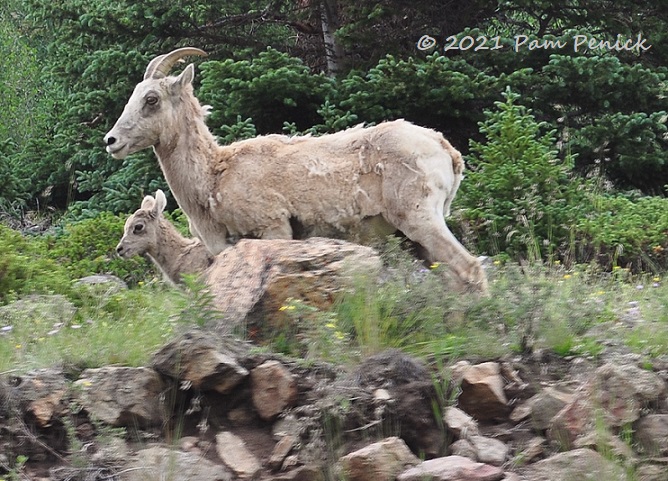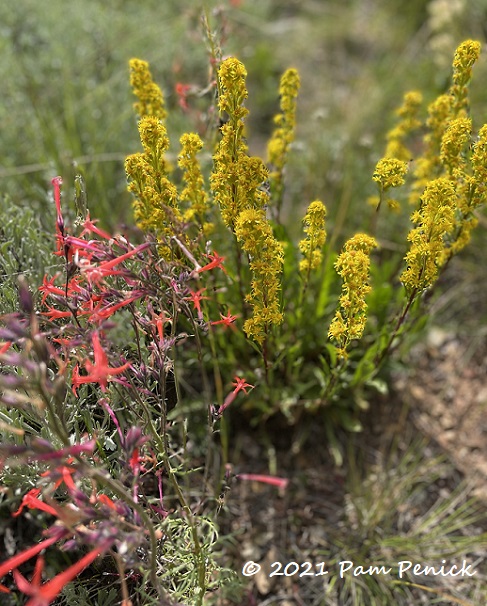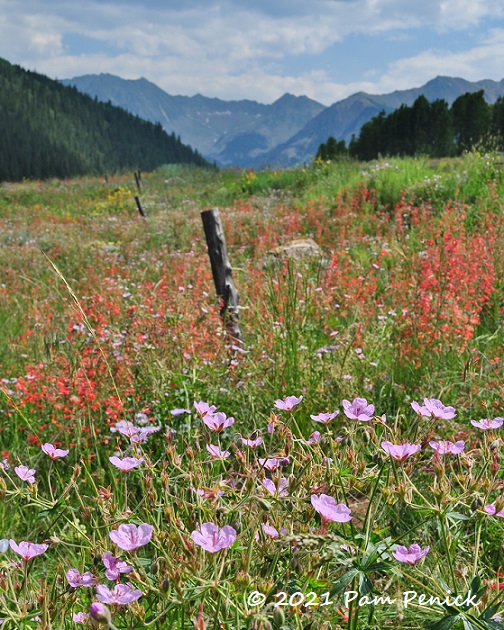Wild bighorn sheep and wildflowers in the Rocky Mountains

Driving to Colorado from Austin entails two days of sitting in the car and letting the wide-open, arid landscape of West Texas and northern New Mexico fly by. Some people find it boring, but I don’t. I enjoy the vast landscape while keeping an eye out for pronghorn antelope on the high plains. I always see a few, usually from a distance but sometimes along roadside fences. When we reach Colorado’s rocky peaks we keep watch for elk. But on this visit we were thrilled to see bighorn sheep!
Bighorn sheep

We were driving west on Highway 82 toward Independence Pass when we saw cars stopped in front of us. A herd of bighorn sheep was crossing the road and climbing the hillside. Luckily I wasn’t driving, and from the window of our stopped car I took photos.

Being inexperienced with Colorado wildlife, at first I thought they were mountain goats because of their short horns. But they are actually female bighorn sheep, whose horns are shorter than the males’, which curl around their ears.

Ewes and lambs kept close together as they bounded up the rocky slope, then stared back at us for a moment before browsing.

The ewes were shedding their winter coats and looking pretty bedraggled.

The lambs looked tidier and exceedingly cute.

Once the sheep were across we left them to their browsing and started the long, slow climb to the Continental Divide, just ahead and above the tree line at 12,000 feet elevation.
Castle Creek Road wildflowers

Another day, while driving around Aspen, we happened upon Castle Creek Road, a quiet 8-mile drive up toward Ashcroft Ghost Town. Aspens lined the roadside like a white picket fence.

Near the end of the road, a meadow of blazing wildflowers opened up along the highway. We pulled over for a closer look.

Summer wildflowers — what a concept to this Texan accustomed to springtime wildflower extravaganzas.

Wild geraniums and scarlet gilia (Ipomopsis aggregata)

Beautiful, aren’t they?

It was our first taste of peak wildflower season in Colorado. We would see more at Maroon Bells later that week.

Wildflowers and mountain peaks

I think this is Gunnison’s sego lily (Calochortus gunnisonii var. gunnisonii).

Another view

I don’t know these, but they’re lovely. Update: It’s mountain goldenrod (Solidago multiradiata).

Good old asters

What a stunning scene in mid-July, surely the peak of wildflower season at Colorado’s high elevations.

Up next: Roping and riding at the Snowmass Rodeo. For a look back at my tour of the Betty Ford Alpine Gardens in Vail, click here.
__________________________
Digging Deeper
Come learn about gardening and design at Garden Spark! I organize in-person talks by inspiring designers, landscape architects, authors, and gardeners a few times a year in Austin. These are limited-attendance events that sell out quickly, so join the Garden Spark email list to be notified in advance; simply click this link and ask to be added. Season 8 kicks off in fall 2024. Stay tuned for more info!
All material © 2025 by Pam Penick for Digging. Unauthorized reproduction prohibited.


Gorgeous photos. Fun to to see the ewes and lambs together. We see them regularly here (west of Calgary, AB) regularly. Humans don’t seem to concern them so will ‘pose’ for great shots. If you were to see sheep and goats together you would definitely notice the difference. The yellow wildflower is a short goldenrod a favourite pollinator plant.
Thanks for the ID, Elaine!
I love seeing those Mountain Goats. They do look scruffy. You sure hit this area at the right time to see wildflowers. It is so colorful.
Bighorns, but yes — so scruffy! 🙂
Hey Pam! Another name for the sego lily is mariposa lily…they are my favorite Colorado wildflower, a true piece of art. Their bulbs saved many a Ute and pioneer who were starving during the Utah famine of 1848-49.
The red tubular flower in the photo below the lily is called scarlet gilia and hummingbirds love it. The yellow flowers in the same photo is mountain goldenrod.
Love your photos, as always!
Thank you for the pioneer story (I’ll have to read more about that) and the plant IDs, Ruthie!
The red/orange flowers are Scarlet Gilia, Ipomopsis aggregata.
Thank you, Erin!